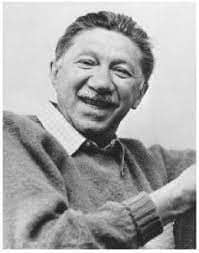Considered the Fourth Force in psychology, after psychoanalysis, behavorism, and humanistic psychology, the transpersonal movement returns the spiritual dimension to understanding of human experience
The first forces in American Psychology
Although mostly forgotten over the years, the nineteenth century birth of psychology in the United States included the dimensions of consciousness, spiritual experience, and moral evaluation of life. William James, one of the founders of the new discipline of psychology in North America, authored The Varieties of Religious Experience, still a classic study of spiritual experience as essential to being human. Pointing towards the transpersonal movement that would arise more than half a century later, James (photo right) famously said, “We are like islands in the sea, separate on the surface but connected in the deep.”
James also included the moral dimension in his understanding of psychology. Still apt today is his observation, “A great many people think they are thinking when they are merely rearranging their prejudices.” Sounding much like a contemporary personal growth coach, over a century ago, James recommended, “To change one’s life: 1. Start immediately. 2. Do it flamboyantly. 3. No exceptions.”
Despite this early focus on what it means to be human, the discipline of psychology veered into decades with little attention to the spiritual dimension of life. In Europe, Sigmund Freud brilliantly began to describe the unconscious forces in our psyches. Psychoanalysis brought new perspectives to treating human suffering and ushered into Western culture the practice of looking beneath the surface for motivations and hidden desires, particularly the urges toward sex and violence.
Meanwhile, particularly in the United States, many university academics desired to bring psychology into the domain of experimental science, leading to the dominance of behaviorism for most of the 20th Century. A behaviorist perspective is not without value in psychology, for even from a transpersonal perspective, we learn to observe our behaviors, and their motivational rewards, in order to release those that do not serve us.


However, there are limits to approaches ignoring the natural tendency of humans to move toward health and psychological-spiritual (psychospiritual) growth. (Stan Grof would later coin the word holotropic to describe our movement toward wholeness, from the Greek, holos = wholeness and trepein = movement toward). By the middle of the 20th Century, an increasing dissatisfaction with behaviorist and Freudian approaches to the human psyche gave birth to the humanistic movement in psychology. Abraham Maslow (left) famously wrote about a hierarchy of needs, describing psychological growth as moving in a healthy direction toward the possibility of self-actualization. Presaging the focus on nonordinary states that Grof would bring to psychology, Maslow described “peak experiences,” moments of exhilaration often containing a sense of connection with universal flow or the divine.
The humanistic movement offered a critique of both behaviorism and Freudianism. By focusing on the laboratory study of animals, behaviorism ignored essential human qualities, such as love, self-awareness, self-determination, personal freedom, morality, art, philosophy, religion and conscience. Consciousness itself was forgotten through a discipline not valuing the study of experience. Focusing on behavior alone led to few insights about the moral dimension of human life and culture. Little guidance was offered in examining our negative characteristics, such as lust for power, cruelty, and the tendency to dominate and intentionally attack.
In his critique of psychoanalysis, Maslow argued that Freud and his followers reached conclusions about the human psyche mainly through the study of psychopathology. This generated a biological reductionism and a tendency to explain all psychological processes in terms of the instincts. While this captured part of the picture of being human, the natural tendencies toward health, human connection, and altruistic behaviors were ignored or explained in only biological terms.
The third force, humanistic psychology, brought humanity back into the study of the psyche and the development of therapeutic techniques. Consciousness and the study of healthy populations were once again of interest. A sense of moral dignity and the possibility of transformation were slowly restored. The personal growth and human potential movements began out of the humanistic perspective.
Enter the Transpersonal Movement
And yet, some scholars, including Stan Grof (right), believed something was still missing. Although his research on the healing potential of psychedelics was halted with the prohibition beginning in the late 1960s, Grof had learned from his psychedelics studies that there is a deeply spiritual dimension of the psyche, which included our ability to participate in a cosmic dance of awakening, often opened through what began to be called nonordinary states. Along with several other peers, Grof understood that human history across many cultures had valued nonordinary states for both individual and collective well-being. As Grof later wrote, “The Western Industrial civilization is the only group in the entire human history that doesn’t hold nonordinary states in great esteem, and doesn’t have any use for them; every other culture has spent a lot of time and energy trying to develop ways of inducing nonordinary states.”

Although not always openly discussed, many of the scholars and researchers involved in the formation of transpersonal psychology had their own awakenings, at least in part, through psychedelics. In 1967, a small task force, including Abraham Maslow, Grof, Anthony Sutich, James Fadiman, Miles Vich, and Sonya Margulies, began meeting in Menlo Park, California. Their goal was to create a new branch of psychology that would honor the entire spectrum of human experience, including the study of nonordinary states of consciousness and the spiritual practices of many cultures across the ages that connected humans with the divine. During these discussions, Maslow and Sutich accepted Grof’s suggestion to call this new discipline transpersonal psychology.
Transpersonal psychology was first announced and defined in 1969 with the publication of The Journal of Transpersonal Psychology. In the tradition of social science, this new field was founded on a commitment to open-ended inquiry, experiential and empirical validation, and a values-oriented approach to human experience.
In 1972, the Association for Transpersonal Psychology was established to encourage individual and group learning, cooperation among disciplines, research in theory and application, and the dissemination of information about the field.
On the global level, Grof founded The International Transpersonal Psychology Association, which held its first conference in Iceland in 1973. This was soon followed by the founding in 1975 of the Institute of Transpersonal Psychology (ITP), now Sofia University, a graduate training center. Robert Frager and James Fadiman founded ITP as an experiential program blending academic studies with experiential training in healing modalities and spiritual technologies. Like ITP and other transpersonal training programs, the learning communities developed by Grof have always emphasized simultaneous personal growth and healing along with learning of theory and techniques, for the presence, equilibrium and clarity of the educator/facilitator/therapist is crucial in providing safety, modeling, and optimum transformational space for students and clients. Arising out of the same cultural moment, several other transpersonal programs soon emerged. Among these were Saybrook Graduate School, the California Institute of Asian Studies (now California Institute of Integral Studies), Naropa, and Ubiquity University, founded in 1996 by the originator of Creation Spirituality, Mathew Fox.
In 2007, transpersonal scholars Glenn Hartelius, Marianna Caplan, and Mary Ann Rardin published a retrospective review of transpersonal research published over the 35 years since the origin of the discipline. Their study concluded the major subject areas of the field can be summed up in three themes: beyond-ego psychology, integrative/holistic psychology, and psychology of transformation. Early emphasis on nonordinary states of consciousness had moderated into a broader approach to human transcendence, wholeness, and transformation.
Today, the Journal of Transpersonal Psychology and the Association for Transpersonal Psychology continue to bring transpersonal approaches and focuses to thousands of interested individuals. As established non-profit services, both JTP and ATP continue to extend the transpersonal perspective world-wide.
Hartelius, Caplan and Rardin observed that transpersonal psychology now has much in common with other forms of psychology, including the integral psychology of Ken Wilber, formerly identified as a transpersonal psychologist. As the world has transformed since 1967, many transpersonal understandings formerly considered novel, even provocative, now have footholds in mainstream culture.
In developing the GROF® Legacy Project USA, in partnership with GROF® Legacy Training international, we recognize the time has arrived to build Grofian psychology as a sub-discipline in its own right within the heritage of transpersonal psychology.
